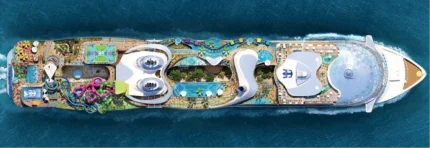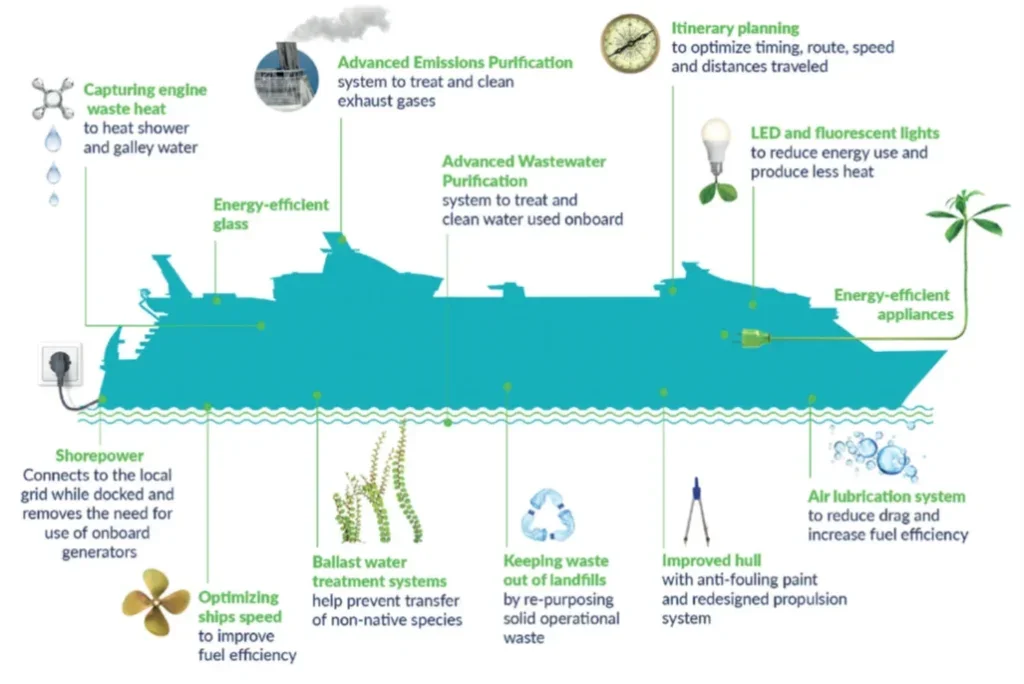
At the end of 2023, Royal Caribbean International took delivery of Icon of the Seas. At 250,800t it is currently the biggest cruise ship in the world, overtaking the Wonder of the Seas. Scheduled for launch in July 2024, the same line’s Utopia of the Seas will weigh in at 231,000t. Earlier this year, Princess Cruises unveiled its largest ever ship, the 175,000t Sun Princess. Disney is not far behind, with the 140,000t Disney Treasure. The pattern? Increasingly large vessels that need to find their place in the industry’s efforts to reduce carbon emissions.
Given that a study published in 2021, which combined evidence from more than 200 research papers on the health of people and the environment in different oceans and seas around the world, found that a large cruise ship can have a bigger carbon footprint than 12,000 cars, and an overnight stay on board uses 12 times more energy than a stay in a hotel, that seems like a tall order.
The industry faces many difficult choices, as there are myriad ways to prioritise and tackle emissions reduction. Energy-efficient technologies and new power sources – from hydrogen and LNG to wind power – are all touted as the answer, but there is no consensus.
“I think it all depends on the availability of fuels,” says Admiral Bill Burke (ret), chief maritime officer for Carnival Corporation. “I have read some reports from economists that say it would take as much renewable energy as existed in the world as of a year ago to produce the synthetic fuel needed for the entire shipping industry. Certainly, a lot of energy is needed.”
In 2022, Professor Stefan Ulreich from Germany’s University of Applied Sciences released a paper titled ‘Fuelling the Fourth Propulsion Revolution’. That report stated that to reach the shipping industry’s 2050 net-zero goal, its fuel needs would require electricity from renewable sources to increase by up to 3,000TWh, the equivalent of the entire world’s renewable energy production at the time.
It found, ultimately, that to achieve the IEA’s netzero emissions target by 2050, the world would need an 18-fold increase in existing renewable production capacity. While renewable energy capacity is increasing across the globe, it is not expanding at the pace required to achieve that level of growth.
“The industry will need a lot more green power, and first you have to green the grid,” notes Burke. “It is doable, but it all depends on the choice of fuel. At the moment, our focus is on conservation. We are aiming to become more efficient. Saving fuel today means we will need less in the future.”
Eyes on the prize
The cruise industry represents a tiny proportion of the overall shipping sector, but it cannot hide behind that fact. Nor can it escape the truth that it has had a historically patchy environmental record.
Members of the Cruise Lines Industry Association (CLIA) have made clear their commitment to reducing carbon intensity as an average across the cruise fleet by 40% by 2030 compared with 2008, which is in line with the International Maritime Organisation (IMO) Revised GHG strategy. Furthermore, it is pursuing net-zero carbon cruising by 2050.
At Carnival, there are clear goals for 2030. Among them are a commitment to achieving a 20% carbon intensity reduction relative to its 2019 baseline; expanding its liquefied natural gas (LNG) programme; optimising the reach and performance of its advanced air quality systems (AAQS) programme; and expanding the use of battery, fuel cell and biofuel technologies. It also aims to reduce emissions associated with food procurement and waste management, and to identify carbon offset options, though only when energy-efficiency options have been exhausted.
It has already achieved a 50% reduction in absolute particulate matter air emissions relative to its 2015 figures, and an increase in fleet shore power connection capability to 60% of the fleet. By 2050, it hopes to reach net-zero emissions from ship operations and achieve 100% fleet shore power.
In April 2024, Royal Caribbean announced that it had already reduced its carbon intensity by 6.8% – more than half of its double-digit reduction target – and stated that it remains firmly on course to become net zero by 2050. Its annual sustainability report – or ‘Seastainability Report’, as it has chosen to call it – stresses its ‘laser-focused’ approach to improving energy efficiency, water treatment and diverting waste from landfill.
“Marking the halfway point to our carbonintensity target is a key milestone that builds on our history of innovation and collaboration as we continue driving forward solutions that advance the industry’s net-zero future,” noted Royal Caribbean group president and CEO Jason Liberty at the time of the announcement.
At MSC Cruises, decarbonisation remains one of its main priorities and net-zero emissions from marine operations by 2050 is in its sights. The company is collaborating with technology companies, shipyards and fuel providers to explore new possibilities, having launched its first LNG- powered ship in 2022. It claims to be on track to meet the IMO goals by 2050, having already reported a 33.5% reduction in emissions in 2022.
Norwegian Cruise Lines (NCL) launched an updated climate action strategy in 2023 with shortand near-term greenhouse gas targets as milestones on its 2050 net-zero journey. The key elements include reducing emissions intensity by 10% by 2026 and 25% by 2030. These include emissions from the company’s fleet islands and facilities as well as fuel and energy-related activities.
Nevertheless, NCL still recognises that many challenges lie ahead, with its vice-president of ESG, investor relations and corporate communications, Jessica John, noting that “we are encouraged to see the significant progress and momentum across sectors to decarbonise, but fundamental challenges continue to exist for the cruise industry to fully decarbonise by 2050”.
“Rather than waiting for these challenges to dissolve, our strategy is about acting now to implement solutions for efficiency today, innovate for future solutions and collaborate with our stakeholders along the way,” she continued. “Underpinning this strategy is good governance and effective risk management as we work to advance our climate action efforts and build our company’s resilience.”
At Ponant, there is a vision to create a zeroemission ship as the next step in fleet renewal.
“Developing a breakthrough innovation requires changes in approach,” says Wassim Daoud, head of CSR and sustainability at Ponant. “We have considered the entire life cycle of the ship to integrate the choice of materials, energy efficiency, and the use of renewable energy. Thus, the future zero-emission ship will be propelled 50% by wind power and the rest by a mixed energy system including green hydrogen, biofuels, synthetic fuels and solar energy.”
“We have set ambitious goals for carbon neutrality, aiming for carbon neutrality by 2040, in advance of the international regulations set date,” he adds. “Our goal is for our future ships to be as close to carbon neutrality as cutting-edge technology allows, be they at sea, manoeuvring, in port or at anchor. We are doing everything possible to meet our decarbonisation trajectory. The road is long and challenging, but we are confident in our ability to innovate.”
Choose your weapons
There are some promising developments in the battle against carbon emissions. Last summer, MSC’s 6,327-passenger MSC Euribia took a four-day journey from Saint-Nazaire, France, to Copenhagen in what the operator touted as a ‘world-first netzero greenhouse gas emission cruise’. The company invested in 400t of bio-liquefied natural gas (LNG) for the voyage, which it hailed as an important step on its path to net-zero emissions.

“We will be proud to share with the entire cruise industry, and the world, the learnings that come for all from this demonstration that net-zero emissions cruising is already possible,” noted Pierfrancesco Vago, executive chairman of the cruise division of MSC Group, at the time.
“Our purchase of bio-LNG will send a clear and meaningful signal to the market that there is demand from cruise lines and the broader maritime industry for cleaner fuels, but we need governments, producers and end users to collaborate and scale-up the availability of these much-needed and new sources of power,” he added. LNG certainly seems to be a popular choice for low-emission fuel, and both Sun Princess and Utopia of the Seas are among the new breed of LNG-powered mega-ships. Yet there are those who believe hydrogen will be the magic bullet.
Viking Cruises, for example, has chosen not to pursue the LNG route. Its chairman, Torstein Hagen, has, in fact, stated his strong opposition to it, claiming it is just another name for methane, which he believes is 80-times worse than carbon dioxide in terms of global warming.
There is scepticism about all the potential avenues for emissions reduction, as Burke makes clear: “I don’t know of anyone that has a net-zero ship today. The only way to do it would be to use all wind power, and while that is part of the future, we won’t be all wind. Our efforts are going into LNG. Our goal is a net-zero emissions ship but we need the right fuels for that, so it is a long time away.
“The choice of fuel is not unanimous but there is a lot of consensus around LNG,” he adds. “Most ships being built today are going to be LNG, whether they are tankers, cruise ships or anything else. With government help we’ll get there and LNG is more efficient than other fuels, and is reasonably priced.”
While some doubt the cruise industry, let alone the entire shipping sector, can reach net-zero emissions, and despite the lack of consensus around key technology decisions, there is no doubt that cruise lines will give their all in trying to change their reputation as major polluters.






